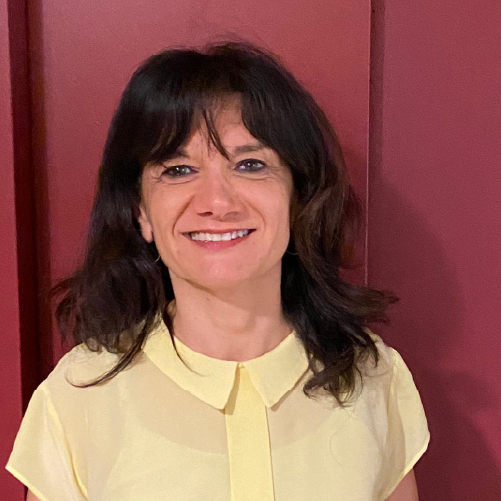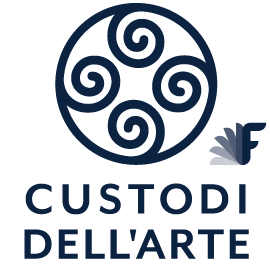

The Church of San Giacomo
The Church of San Giacomo
Riproduci traccia audio
Play audio track
Audio-Track abspielen
The Church of San Giacomo
Trascrizione traccia audio
For twenty-five years an important part of my life has revolved around the eighteenth-century church of San Giacomo. Its doors remain open until late in the evening, creating a continuous protective bond between the internal space and the city, starting from the statue of the Madonna, in painted terracotta, placed on the facade as a sign of thanks. As a result of a strong earthquake in 1875 whilst there were no victims, most of the houses were destroyed, except the wall of the Church Tower, which housed the statue. This remained standing and from that moment on, it has always borne the inscription Ave Salus Populi. (Hail the saviour of the people)
On entering the church, to the left, in the second altar, we find another statue of Mary, which has a particular meaning for our community. Every year, there is a large procession to commemorate the day of Assumption on 15th August and the statue is taken to sea. Holy Mass is celebrated at 8 in the morning in the church. The light at that hour is already incredible and the statue, accompanied by a brass quintet, is carried to the Piazza Ciceruacchio, in front of the library, where it is placed on a boat that travels along the canal to the open sea. The sun is now high in the sky and the light sparkles on the surface of the water. The townsfolk follow the boat with the Madonna by alighting all kind of boats, motorised and even those with pedals.
At the exit of the canal, the noise of the procession and the music of the brass band, attracts swimmers who flock from both sides, if only to make the sign of the cross. The statue, on the main boat leading the procession, then stops at a point in the sea between the west and east sides of town, a blessing to the sea is made and a wreath, in memory of the fallen, is thrown into the water.
Now imagine the church wrapped in the cold of winter, at the end of Midnight Mass on Christmas eve. We leave the church accompanied by the choir who are singing. The canal glitters with the lights of the nativity scene exhibited onboard the antique boats. The characters of the nativity are made from the same materials with which boats are built and sails decorated: wood, wax, nets and canvas. Next to the Holy Family we find the other characters typical of a fishing village, busy with their different trades. All that is missing from scene is the Baby Jesus which is covered by a veil and lifted onto the boats by the parish priest and the mayor. At the end of the ceremony, there is time for a toast and the exchange of yuletide wishes.
Just two weeks later and here in Cesenatico it is time for the Pasquaroli to visit. The name of these traditional musicians (which sounds a little like the Italian word for Easter) is not meant to not mislead; they arrive on the day of the Epiphany (6th January which is the 12th Night of Christmas) from the villages inland, where they have gone from house to house singing Pasquella (their traditional songs) in exchange for food and wine. Our Parish also has their own group of Pasquaroli.
It is a tradition held of the end of the holidays, where new year greetings are exchanged and good wishes given for the next important celebration, which is Easter.
There are many family and communal events that this church has witnessed over time, always punctuated by the ringing of its bells, just like towards the end of the Second World War, when the Germans blew up the bell tower, as they did to many others in the area, so as not to be spotted whilst they fled. The town of Cesenatico rebuilt the tower and new bells were donated to the town. It is specifically from their sound that this community is regenerated each time they are rung.
Audio Track transcription
For twenty-five years an important part of my life has revolved around the eighteenth-century church of San Giacomo. Its doors remain open until late in the evening, creating a continuous protective bond between the internal space and the city, starting from the statue of the Madonna, in painted terracotta, placed on the facade as a sign of thanks. As a result of a strong earthquake in 1875 whilst there were no victims, most of the houses were destroyed, except the wall of the Church Tower, which housed the statue. This remained standing and from that moment on, it has always borne the inscription Ave Salus Populi. (Hail the saviour of the people)
On entering the church, to the left, in the second altar, we find another statue of Mary, which has a particular meaning for our community. Every year, there is a large procession to commemorate the day of Assumption on 15th August and the statue is taken to sea. Holy Mass is celebrated at 8 in the morning in the church. The light at that hour is already incredible and the statue, accompanied by a brass quintet, is carried to the Piazza Ciceruacchio, in front of the library, where it is placed on a boat that travels along the canal to the open sea. The sun is now high in the sky and the light sparkles on the surface of the water. The townsfolk follow the boat with the Madonna by alighting all kind of boats, motorised and even those with pedals.
At the exit of the canal, the noise of the procession and the music of the brass band, attracts swimmers who flock from both sides, if only to make the sign of the cross. The statue, on the main boat leading the procession, then stops at a point in the sea between the west and east sides of town, a blessing to the sea is made and a wreath, in memory of the fallen, is thrown into the water.
Now imagine the church wrapped in the cold of winter, at the end of Midnight Mass on Christmas eve. We leave the church accompanied by the choir who are singing. The canal glitters with the lights of the nativity scene exhibited onboard the antique boats. The characters of the nativity are made from the same materials with which boats are built and sails decorated: wood, wax, nets and canvas. Next to the Holy Family we find the other characters typical of a fishing village, busy with their different trades. All that is missing from scene is the Baby Jesus which is covered by a veil and lifted onto the boats by the parish priest and the mayor. At the end of the ceremony, there is time for a toast and the exchange of yuletide wishes.
Just two weeks later and here in Cesenatico it is time for the Pasquaroli to visit. The name of these traditional musicians (which sounds a little like the Italian word for Easter) is not meant to not mislead; they arrive on the day of the Epiphany (6th January which is the 12th Night of Christmas) from the villages inland, where they have gone from house to house singing Pasquella (their traditional songs) in exchange for food and wine. Our Parish also has their own group of Pasquaroli.
It is a tradition held of the end of the holidays, where new year greetings are exchanged and good wishes given for the next important celebration, which is Easter.
There are many family and communal events that this church has witnessed over time, always punctuated by the ringing of its bells, just like towards the end of the Second World War, when the Germans blew up the bell tower, as they did to many others in the area, so as not to be spotted whilst they fled. The town of Cesenatico rebuilt the tower and new bells were donated to the town. It is specifically from their sound that this community is regenerated each time they are rung.
Audiotrack-Text
For twenty-five years an important part of my life has revolved around the eighteenth-century church of San Giacomo. Its doors remain open until late in the evening, creating a continuous protective bond between the internal space and the city, starting from the statue of the Madonna, in painted terracotta, placed on the facade as a sign of thanks. As a result of a strong earthquake in 1875 whilst there were no victims, most of the houses were destroyed, except the wall of the Church Tower, which housed the statue. This remained standing and from that moment on, it has always borne the inscription Ave Salus Populi. (Hail the saviour of the people)
On entering the church, to the left, in the second altar, we find another statue of Mary, which has a particular meaning for our community. Every year, there is a large procession to commemorate the day of Assumption on 15th August and the statue is taken to sea. Holy Mass is celebrated at 8 in the morning in the church. The light at that hour is already incredible and the statue, accompanied by a brass quintet, is carried to the Piazza Ciceruacchio, in front of the library, where it is placed on a boat that travels along the canal to the open sea. The sun is now high in the sky and the light sparkles on the surface of the water. The townsfolk follow the boat with the Madonna by alighting all kind of boats, motorised and even those with pedals.
At the exit of the canal, the noise of the procession and the music of the brass band, attracts swimmers who flock from both sides, if only to make the sign of the cross. The statue, on the main boat leading the procession, then stops at a point in the sea between the west and east sides of town, a blessing to the sea is made and a wreath, in memory of the fallen, is thrown into the water.
Now imagine the church wrapped in the cold of winter, at the end of Midnight Mass on Christmas eve. We leave the church accompanied by the choir who are singing. The canal glitters with the lights of the nativity scene exhibited onboard the antique boats. The characters of the nativity are made from the same materials with which boats are built and sails decorated: wood, wax, nets and canvas. Next to the Holy Family we find the other characters typical of a fishing village, busy with their different trades. All that is missing from scene is the Baby Jesus which is covered by a veil and lifted onto the boats by the parish priest and the mayor. At the end of the ceremony, there is time for a toast and the exchange of yuletide wishes.
Just two weeks later and here in Cesenatico it is time for the Pasquaroli to visit. The name of these traditional musicians (which sounds a little like the Italian word for Easter) is not meant to not mislead; they arrive on the day of the Epiphany (6th January which is the 12th Night of Christmas) from the villages inland, where they have gone from house to house singing Pasquella (their traditional songs) in exchange for food and wine. Our Parish also has their own group of Pasquaroli.
It is a tradition held of the end of the holidays, where new year greetings are exchanged and good wishes given for the next important celebration, which is Easter.
There are many family and communal events that this church has witnessed over time, always punctuated by the ringing of its bells, just like towards the end of the Second World War, when the Germans blew up the bell tower, as they did to many others in the area, so as not to be spotted whilst they fled. The town of Cesenatico rebuilt the tower and new bells were donated to the town. It is specifically from their sound that this community is regenerated each time they are rung.
Narrato da
Narrated by
Mehr Infos



